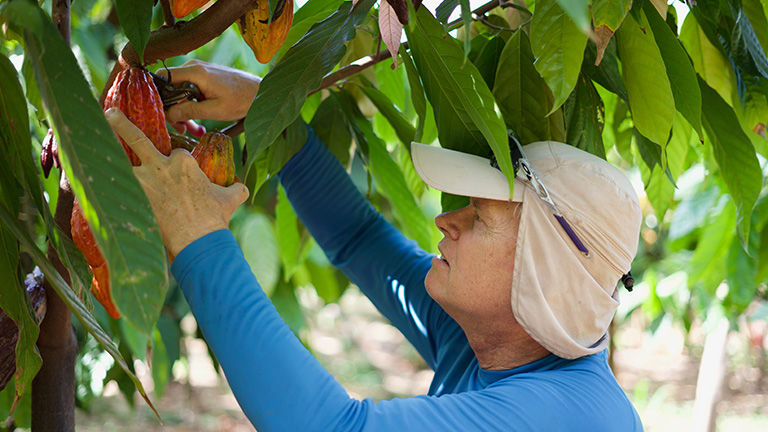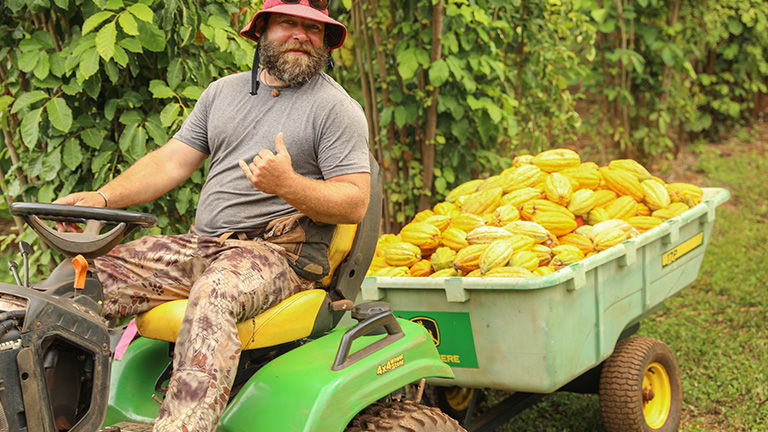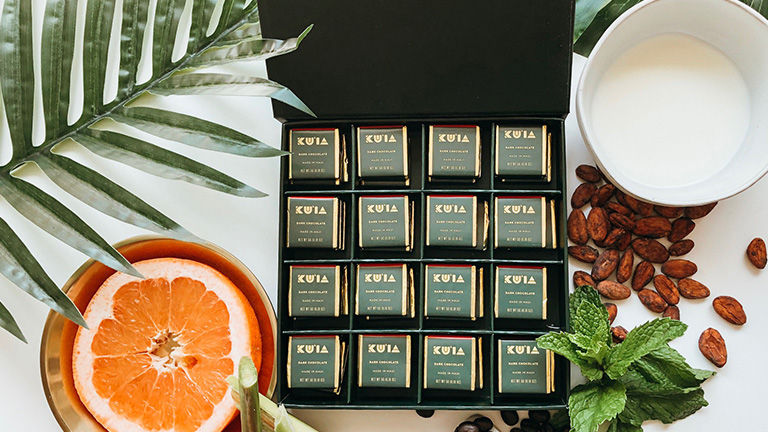In the arid foothills of the West Maui Mountains, Maui Kuia Estate Chocolate (MKEC) is cultivating an oasis of cacao, the key ingredient in America’s most popular sweet: chocolate. And retired biotech entrepreneur Gunars Valkirs is at the helm, making premium chocolate and giving back to the local community.
During a 90-minute Guided Cacao Farm Tour & Chocolate Tasting at MKEC, my guide, Lucas, explained Valkirs’ passion project while skillfully navigating a winding, bumpy road to a patch of greenery. As the story goes, as Valkirs — MKEC’s founder and CEO — began to solidify his chocolatey plans, he met Daniel O’Doherty, a botanist highly regarded for his research and work in cacao production worldwide. The two Maui residents bonded over their shared interest, and O’Doherty came onboard as MKEC’s vice president of farm and factory operations.
Cacao needs a tropical environment to thrive, and Hawaii is one of the only places in the U.S. where it can be grown outside a greenhouse. MKEC makes some two-dozen chocolate products, about 20% of which are made from its Maui-grown cacao. The rest of the brand’s cacao comes from farms in Uganda and Ecuador that O’Doherty has carefully vetted.
“We’ve leased 60 acres of former sugarcane land and are currently growing cacao on just 20 of those acres — about 8,000 trees,” Lucas said. “We have a lot of space to expand, but not without challenges.”
Those challenges include direct sunlight and strong winds: It’s typically hot and dry in the area, and gusts can reach 80 miles per hour. To help the cacao flourish, the farm has planted protective barriers of lofty neem trees and panax shrubs.
Touring the Farm
As we walked, Lucas gave our group a fascinating introduction to cacao, noting how it takes four to six months for pods to mature and the 35 to 50 reddish-brown beans inside to ripen. A cacao tree will produce some 100 pods twice annually, but only about 20% of them will reach maturity.
 Gunars Valkirs, founder and CEO of Maui Kuia Estate Chocolate, harvests a ripe cacao pod at the company’s farm.
Gunars Valkirs, founder and CEO of Maui Kuia Estate Chocolate, harvests a ripe cacao pod at the company’s farm.
Credit: 2023 Maui Kuia Estate Chocolate“The tree is super smart,” Lucas said. “It chooses 20 or so of its best pods and directs energy to them. The other pods — about 80 — will dehydrate on the tree."
Cacao can grow to 50 feet tall, but at MKEC, they’re kept around a height of 15 feet to facilitate harvesting, all of which is done by hand with shears. Ripe pods weigh 1 to 2 pounds and — exhibiting another evolutionary feat — they grow near the bottom weight-bearing part of the tree. Each tree yields enough beans to make 1 to 2 pounds of chocolate during the two primary harvesting seasons in the spring and fall.
By cross-pollinating the three main varieties of cacao — criollo, forastero and trinitario — O’Doherty and his team have created 40 varieties unique to MKEC.
 A worker hauls ripe cacao pods that are ready for processing.
A worker hauls ripe cacao pods that are ready for processing.
Credit: 2023 Maui Kuia Estate Chocolate“The beans produced have different nuances,” Lucas said. “When we make our chocolate, we don’t separate the varieties; we blend them, which is why the flavors are so complex. The terroir — or place where cacao is grown — also greatly influences how the chocolate made from it tastes. You won’t taste chocolate like ours anywhere else in the world.”
A Chocolate Sampling
As he explained the fermentation, drying, roasting and milling processes, Lucas passed around big jars filled with whole beans, nibs and crushed nibs or cocoa powder, urging us to sniff and closely examine them. Then came the most anticipated part of the tour: a tasting session in a treehouse built among the cacao.
“Put the chocolate at the back of your mouth and let it melt on your tongue,” Lucas advised. “That’s the best way to experience all the flavor profiles.”
We sampled nine kinds of chocolate, all made in MKEC’s 9,000-square-foot, solar-powered factory, reputedly the largest chocolate-making facility in Hawaii. Among the three single-estate chocolates was Maui Kuia Estate Dark Chocolate — made from MKEC’s Maui-grown cacao — which won a coveted Good Food Award in 2022. The previous year, MKEC received a Gold Award/Asia-Pacific region in the Cacao of Excellence competition, which recognizes producers worldwide for their growing expertise and the quality, diversity and exceptional flavors of their beans.
The descriptions of the chocolates mirrored those often heard at wine tastings, including “smooth,” “nutty,” “buttery” and “fruit-forward.”
For its fruit-infused products, MKEC makes it a priority to source locally.
“Our calamansi [a citrus hybrid] comes from trees in Gunars’ backyard,” Lucas said. “We pick wild guava in the hills of West Maui. The mango we use is Mapulehu, a juicy variety that was developed on Molokai. You can’t buy it in stores or farmers markets on Maui; to get it, you have to know someone who grows it. Our Mapulehu mangoes come from five trees on our farm.”
 MKEC uses a variety of locally sourced ingredients for many of its products.
MKEC uses a variety of locally sourced ingredients for many of its products.
Credit: 2023 Maui Kuia Estate ChocolateWhen the tour concluded at the retail store, everyone began looking for their favorites. Some visitors were considering signing up for a 60-minute guided or self-guided tasting in the spacious, open-air Chocolate Bar on the second floor, where wine, beer and spirits can be paired with three three-piece flights. A portion of the proceeds from the weekend Laulima tastings — led by either Valkirs or O’Doherty — goes to a rotating group of some 30 nonprofits, including Maui Food Bank, Whale Trust Maui, Maui Arts League and Na Leo Kalele, a Hawaiian language immersion program.
On Sunday evenings, music-lovers 21 years and older can gather at the Chocolate Bar for Sunset Jazz performances, where all proceeds go to Jazz Maui, a program of the nonprofit Arts Education for Children Group. Chocolate flights and alcoholic beverage pairings are available for purchase.
If visitors are lucky, they’ll see workers molding chocolate through a large window in the store, usually Mondays through Thursdays (the time varies, depending on the production schedule). Several steps are required to transform cacao, cocoa butter, sugar and flavorings into the treat we all love — but that’s a story for another time.